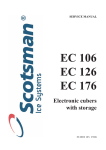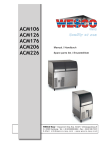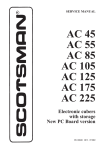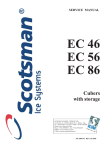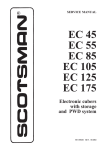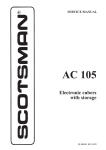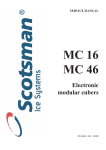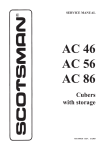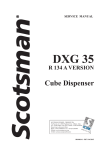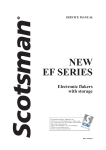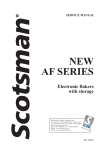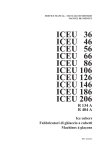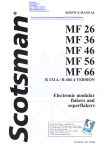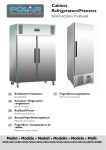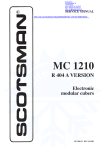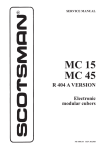Download electronic cuber model ec 106
Transcript
Page 1 Page 1 SERVICE MANUAL EC 106 EC 126 EC 176 EC 206 EC 226 Electronic cubers with storage New PC Board version SCOTSMAN EUROPE - FRIMONT SPA Via Puccini, 22 - 20010 Pogliano M.se - Milano - Italy Tel. +39-02-93960.1 (Aut. Sel.)- Telefax +39-02-93550500 Direct Line to Service & Parts: Phone +39-02-93960350 - Fax +39-02-93540449 ISO 900 1-C Website: www.scotsman-ice.com ert. n. 0 080 E-Mail: [email protected] MS 1000.90 - REV. 02/2010 AMPS START AMPS WATTS 3,3 18 550 4,0 19 600 5,6 26 760 A/EC 106 A A/EC 106 W A/EC 126 A A/EC 126 W A/EC 176 A A/EC 176 W KWH/24HRS REFR. CHARGE R134a 10,3 9,4 14,00 11,8 15,0 13,5 320 gr 250 gr 450 gr 300 gr 450 gr 330 gr SUCT. PRESS. END. FREEZE DISCHARGE PRESSURE 8,5 ÷ 9,5 bar 9,5 ÷ 10,5 bar 8,5 ÷ 9,5 bar 9 bar 8,5 ÷ 9,5 bar 9 bar 0 ÷ 0,1 bar 0 ÷ 0,1 bar 0 ÷ 0,1 bar DIP SWITCH FACTORY SETTING COMBINATIONS (PER MODEL AND VERSION) COMBINAISON DES COMMUTATEURS NUMERIQUES DU DIP SWITCH POUR MODELES ET VERSIONS REGOLAZIONE TASTI DIP SWITCH PER MODELLO E VERSIONE DIP SWITCH A/ECM 106 A A/ECM 106 W A/ECL 106 A A/ECL 106 W A/ECS 126-176 A A/ECS 126-176 W A/ECM 126 A A/ECM 126 W A/ECL 126 A A/ECL 126 W A/ECM 176 A A/ECM 176 W A/ECL 176 A A/ECL 176 W FREEZING CYCLE DEFROST CYCLE CYCLE DE CONGÉLATION CYCLE DE DÉMOULAGE CICLO CONGELAMENTO CICLO SBRINAMENTO 1 2 3 4 5 6 ON ON OFF ON ON OFF ON ON OFF ON ON OFF OFF OFF OFF ON OFF ON OFF OFF OFF ON OFF ON ON ON OFF ON OFF ON ON ON OFF ON OFF ON ON ON OFF ON ON OFF ON ON OFF ON OFF ON ON ON ON OFF OFF ON ON ON ON OFF OFF ON ON ON OFF ON OFF ON ON ON OFF ON OFF ON OFF OFF OFF ON OFF ON OFF OFF OFF ON OFF ON TIMED PORTION FREEZING CYCLE TEMPS PHASE TEMPORISÉE CONGELATION TEMPI FASE TEMPORIZZATA CONGELAMENTO 1 ON OFF ON OFF ON OFF ON OFF ON OFF ON OFF ON 2 ON ON OFF OFF ON ON OFF OFF ON ON OFF OFF ON 7 8 3 ON ON ON ON OFF OFF OFF OFF ON ON ON ON OFF 4 ON ON ON ON ON ON ON ON OFF OFF OFF OFF OFF ADDITIONAL DEFROST TIME TEMPS AJOUTÉS TEMPI AGG. SCONGELAMENTO ON ON 0 OFF ON 30 sec. ON OFF 60 sec. 7 OFF 1 min. 3 min. 5 min. 7 min. 9 min. 11 min. 13 min. 15 min. 17 min. 19 min. 21 min. 23 min. 25 min. LED STATUS ON STEADY FIXE FISSO WATER PUMP OFF DURING DEFROST POMPE A L’ARRÊT PEND. DEGIVRAGE POMPA ACQUA DURANTE SBRINAMENTO 8 ON ON ON ON ON ON ON ON ON ON ON ON ON ON AIR/EAU ARIA/ACQUA 9 OFF OFF OFF OFF OFF OFF OFF OFF OFF OFF OFF OFF OFF OFF 10 ON OFF ON OFF ON OFF ON OFF ON OFF ON OFF ON OFF REASON WHY - SIGNIFICATION - SIGNIFICATO FREEZING CYCLE EN RÉFRIGÉRATION IN CONGELAMENTO BLINKING 60 MINUTES DELAY AT START UP JUMPER J3 OUT CLIGNOTANT 60 MINUTES DE RETARD AU DEMARRAGE - CAVALIER J3 OUVERTE LAMPEGGIANTE 60 MINUTI RITARDO PARTENZA - CONTATTI J3 APERTI ON STEADY FIXE FISSO TOO HI DISCHARGE PRESSURE/TEMP. COUPURE HP FERMATA ALTA TEMP. CONDENSAZIONE BLINKING TOO HI EVAP. TEMP. (> 0°C) AFTER 15’ FROM START UP CLIGNOTANT COUPURE BP ( > 0°C LU PAR LA SONDE EVAP. NON ATTEINTE APRES 15’ FONCT.) LAMPEGGIANTE TEMP. EVAP. > 0°C DOPO 15’ DA INIZIO CONGELAMENTO ON STEADY FIXE FISSO UNIT OFF AT BIN FULL CABINE PLEINE CONTENITORE PIENO BLINKING SLOW I/R BEAM CUTTED CLIGNOTANT LENT FAISCEAU INFRA ROUGE CELLULE NIVEAU GLACE INTERROMPU LAMPEGG. LENTO RAGGIO INFRAROSSO INTERROTTO BLINKING FAST I/R ON AFTER TRIP OFF AT BIN FULL CLIGNOTANT RAPIDE FAISCEAU INFRA ROUGE CELLULE NIVEAU GLACE ETABLI LAMPEGG. VELOCE RAGGIO INFRAROSSO RIPRISTINATO DOPO FERMATA A CONT. PIENO ON STEADY FIXE FISSO I/R CALIBRATION DONE CALIBRATION FAISCEAU INFRA ROUGE CELL. NIVEAU GLACE REALISÉ CALIBRAZIONE RAGGIO INFRAROSSO EFFETTUATA BLINKING UNIT IN CLEANING MODE OR TRIPPING OFF AFTER TEST - JUMPER TEST IN CLIGNOTANT MACHINE EN MODE DETARTRAGE OU ARRÊTE APRES LE TEST - CAVALIER TEST FERMÉ LAMPEGGIANTE MACCHINA NELLA FASE LAVAGGIO O FERMA DOPO IL TEST - PONTICELLO TEST CHIUSO ON STEADY FIXE FISSO CONDENSER SENSOR OUT OF ORDER SONDE CONDENSEUR HS SONDA CONDENSATORE MALFUNZIONANTE BLINKING EVAPORATOR SENSOR OUT OF ORDER CLIGNOTANT SONDE EVAPORATEURS HS LAMPEGGIANTE SONDA EVAPORATORE MALFUNZIONANTE BLINKING ALTERNATIV. I/R SENSOR OUT OF ORDER CLIGNOTANT ALTERNÉ SONDE INFRA ROUGE CELLULE NIVEAU GLACE HS LAMPEGGIO ALTERN. SONDA ALL’INFRAROSSO LIVELLO GHIACCIO MALFUNZIONANTE 8 OFF 7 ON ON ON ON ON ON ON ON OFF OFF ON ON ON ON 15/30" PUSH PUSH > 5” DURING WATER FILLING TO MOVE THE UNIT INTO FREEZING PUSH > 5” DURING FREEZING TO MOVE THE UNIT INTO DEFROST PUSH > 5” DURING DEFROST TO MOVE THE UNIT INTO FREEZING PUSH 2” ÷ 5” DURING WATER FILLING TO MOVE THE UNIT INTO CLEANING PUSH DURING THE 60 MIN START UP DELAY TIME TO BY-PASS IT AMPS START AMPS WATTS 4,7 19 950 5,2 29 1180 A/EC 206 A A/EC 206 W A/EC 226 A A/EC 226 W KWH/24HRS REFR. CHARGE R404a 20,8 17,3 24,2 19,2 320 gr 250 gr 450 gr 300 gr SUCT. PRESS. END. FREEZE DISCHARGE PRESSURE 15 ÷ 17 bar 17 bar 15 ÷ 17 bar 17 bar 1,7 bar 1,7 bar DIP SWITCH FACTORY SETTING COMBINATIONS (PER MODEL AND VERSION) COMBINAISON DES COMMUTATEURS NUMERIQUES DU DIP SWITCH POUR MODELES ET VERSIONS REGOLAZIONE TASTI DIP SWITCH PER MODELLO E VERSIONE FREEZING CYCLE CYCLE DE CONGÉLATION CICLO CONGELAMENTO DIP SWITCH A/ECS 226 A A/ECM 206-226 A A/ECM 206-226 W A/ECL 206 A A/ECL 206 W 2 ON ON OFF OFF ON ON OFF OFF ON ON OFF OFF ON 7 8 2 3 4 5 6 7 8 9 10 OFF ON ON OFF OFF ON OFF OFF OFF OFF ON ON ON ON ON OFF OFF OFF OFF OFF ON ON ON ON ON ON ON ON ON ON ON ON ON ON ON ON ON ON ON ON ON ON OFF ON OFF 3 ON ON ON ON OFF OFF OFF OFF ON ON ON ON OFF 4 ON ON ON ON ON ON ON ON OFF OFF OFF OFF OFF ON 0 ON 30 sec. ON OFF 60 sec. OFF OFF 1 min. 3 min. 5 min. 7 min. 9 min. 11 min. 13 min. 15 min. 17 min. 19 min. 21 min. 23 min. 25 min. ADDITIONAL DEFROST TIME TEMPS AJOUTÉS TEMPI AGG. SCONGELAMENTO ON 8 AIR/EAU ARIA/ACQUA 1 OFF 7 15/30" ON ON ON OFF OFF TIMED PORTION FREEZING CYCLE TEMPS PHASE TEMPORISÉE CONGELATION TEMPI FASE TEMPORIZZATA CONGELAMENTO 1 ON OFF ON OFF ON OFF ON OFF ON OFF ON OFF ON DEFROST CYCLE CYCLE DE DÉMOULAGE CICLO SBRINAMENTO WATER PUMP OFF DURING DEFROST POMPE A L’ARRÊT PEND. DEGIVRAGE POMPA ACQUA DURANTE SBRINAMENTO LED STATUS ON STEADY FIXE FISSO REASON WHY - SIGNIFICATION - SIGNIFICATO FREEZING CYCLE EN RÉFRIGÉRATION IN CONGELAMENTO BLINKING 60 MINUTES DELAY AT START UP JUMPER J3 OUT CLIGNOTANT 60 MINUTES DE RETARD AU DEMARRAGE - CAVALIER J3 OUVERTE LAMPEGGIANTE 60 MINUTI RITARDO PARTENZA - CONTATTI J3 APERTI ON STEADY FIXE FISSO TOO HI DISCHARGE PRESSURE/TEMP. COUPURE HP FERMATA ALTA TEMP. CONDENSAZIONE BLINKING TOO HI EVAP. TEMP. (> 0°C) AFTER 15’ FROM START UP CLIGNOTANT COUPURE BP ( > 0°C LU PAR LA SONDE EVAP. NON ATTEINTE APRES 15’ FONCT.) LAMPEGGIANTE TEMP. EVAP. > 0°C DOPO 15’ DA INIZIO CONGELAMENTO ON STEADY FIXE FISSO UNIT OFF AT BIN FULL CABINE PLEINE CONTENITORE PIENO BLINKING SLOW I/R BEAM CUTTED CLIGNOTANT LENT FAISCEAU INFRA ROUGE CELLULE NIVEAU GLACE INTERROMPU LAMPEGG. LENTO RAGGIO INFRAROSSO INTERROTTO BLINKING FAST I/R ON AFTER TRIP OFF AT BIN FULL CLIGNOTANT RAPIDE FAISCEAU INFRA ROUGE CELLULE NIVEAU GLACE ETABLI LAMPEGG. VELOCE RAGGIO INFRAROSSO RIPRISTINATO DOPO FERMATA A CONT. PIENO ON STEADY FIXE FISSO I/R CALIBRATION DONE CALIBRATION FAISCEAU INFRA ROUGE CELL. NIVEAU GLACE REALISÉ CALIBRAZIONE RAGGIO INFRAROSSO EFFETTUATA BLINKING UNIT IN CLEANING MODE OR TRIPPING OFF AFTER TEST - JUMPER TEST IN CLIGNOTANT MACHINE EN MODE DETARTRAGE OU ARRÊTE APRES LE TEST - CAVALIER TEST FERMÉ LAMPEGGIANTE MACCHINA NELLA FASE LAVAGGIO O FERMA DOPO IL TEST - PONTICELLO TEST CHIUSO ON STEADY FIXE FISSO CONDENSER SENSOR OUT OF ORDER SONDE CONDENSEUR HS SONDA CONDENSATORE MALFUNZIONANTE BLINKING EVAPORATOR SENSOR OUT OF ORDER CLIGNOTANT SONDE EVAPORATEURS HS LAMPEGGIANTE SONDA EVAPORATORE MALFUNZIONANTE BLINKING ALTERNATIV. I/R SENSOR OUT OF ORDER CLIGNOTANT ALTERNÉ SONDE INFRA ROUGE CELLULE NIVEAU GLACE HS LAMPEGGIO ALTERN. SONDA ALL’INFRAROSSO LIVELLO GHIACCIO MALFUNZIONANTE PUSH PUSH > 5” DURING WATER FILLING TO MOVE THE UNIT INTO FREEZING PUSH > 5” DURING FREEZING TO MOVE THE UNIT INTO DEFROST PUSH > 5” DURING DEFROST TO MOVE THE UNIT INTO FREEZING PUSH 2” ÷ 5” DURING WATER FILLING TO MOVE THE UNIT INTO CLEANING PUSH DURING THE 60 MIN START UP DELAY TIME TO BY-PASS IT Page 2 INDICE Page 2 Table of contents Specifications EC 106 Specifications EC 126 Specifications EC 176 Specifications EC 206 Specifications EC 226 page 2 3 5 7 9 11 GENERAL INFORMATION AND INSTALLATION Introduction Unpacking and Inspection Location and levelling Electrical connections Water supply and drain connections Final check list Installation practice 13 13 13 13 14 14 15 OPERATING INSTRUCTIONS Start up Operational checks 16 17 OPERATING PRINCIPLES (How it works) Freezing cycle Harvest cycle Electrical sequence Components description 22 25 26 29 ADJUSTMENT, REMOVAL AND REPLACEMENT PROCEDURES Adjustment of the cube size Wiring diagram EC 106 - EC 126 - EC 176 - EC 206 - EC 226 Service diagnosis 33 34 35 MAINTENANCE AND CLEANING INSTRUCTIONS General Icemaker Clean - Replace of air condenser filter Cleaning instructions of water system 38 38 38 39 Page 3 Page 3 SPECIFICATIONS ELECTRONIC CUBER MODEL EC 106 Important operating requirements: MIN. Air temperature 10°C Water temperature 5°C Water pressure 1 bar Electr. voltage variations from voltage rating specified on nameplate -10% MAX. 40°C 35°C 5 bar +10% ice making capacity WATER COOLED MODELS AIR COOLED MODELS Kg. o °C Kg. 50 10 51 48 21 42 32 40 38 38 36 34 32 21 47 45 32 43 38 41 39 37 AMBIENT TEMPERATURE 44 ICE PRODUCED PER 24 HRS. 46 AMBIENT TEMPERATURE ICE PRODUCED PER 24 HRS. 10 49 35 32 27 21 15 WATER TEMPERATURE 10 o°C 32 27 21 15 10 o°C WATER TEMPERATURE NOTE. With the unit in "built-in" conditions, the ice production is gradually reduced in respect to the levels shown in the graf, up to a maximum of 10% at room temperatures higher than 32°C. The daily ice-making capacity is directly related to the condenser air inlet temperature, water temperature conditions of the condenser air filter and age of the machine. To keep your SCOTSMAN CUBER at peak performance levels, periodic maintenance checks must be carried out as indicated on Maintenance and Cleaning section of this manual. Page 4 Page 4 SPECIFICATIONS Dimensions: HEIGHT (without legs) 850 mm. HEIGHT (with legs) 970 mm. WIDTH 530 mm. DEPTH 600 mm. WEIGHT 54 Kgs. EC 106 - CUBER machine specifications Model Cond. unit Finish Comp. HP Air Water Stainless steel 3/8 EC 106 AS 6 EC 106 WS 6 Basic electr. Amps Start Amps . Watts 230/50/1 3.3 18 550 Cubes per harvest: 32 medium * A 15°C water temperature Electric power cons. Kwh per 24 Hr 10.3 9.4 Bin Capacity 23 Kg. Nr. of wires 3 x 1.5 mm2 Water req. lt/24 HR 0136 ** 550* Amps fuse 10 Page 5 Page 5 SPECIFICATIONS ELECTRONIC CUBER MODEL EC 126 Important operating requirements: MAX. 40°C 35°C 5 bar MIN. Air temperature 10°C Water temperature 5°C Water pressure 1 bar Electr. voltage variations from voltage rating specified on nameplate -10% +10% ice making capacity WATER COOLED MODELS °C o 21 65 60 32 55 38 50 45 32 27 21 15 WATER TEMPERATURE 10 o°C AMBIENT TEMPERATURE 70 ICE PRODUCED PER 24 HRS. 75 10 ICE PRODUCED PER 24 HRS. °C o Kg. 75 10 21 70 32 38 65 60 55 50 AMBIENT TEMPERATURE AIR COOLED MODELS Kg. 45 32 27 21 15 10 WATER TEMPERATURE NOTE. With the unit in "built-in" conditions, the ice production is gradually reduced in respect to the levels shown in the graf, up to a maximum of 10% at room temperatures higher than 32°C. The daily ice-making capacity is directly related to the condenser air inlet temperature, water temperature conditions of the condenser air filter and age of the machine. To keep your SCOTSMAN CUBER at peak performance levels, periodic maintenance checks must be carried out as indicated on Maintenance and Cleaning section of this manual. Page 6 Page 6 SPECIFICATIONS Dimensions: HEIGHT (without legs) 930 mm. HEIGHT (with legs) 1050 mm. WIDTH 680 mm. DEPTH 600 mm. WEIGHT 75 Kgs. EC 126 - CUBER machine specifications Model Cond. unit Finish Comp. HP Air Water Stainless steel 1/2 EC 126 AS 6 EC 126 WS 6 Basic electr. Amps Start Amps . Watts 230/50/1 4 19 600 Cubes per harvest: 48 medium * A 15°C water temperature Electric power cons. Kwh per 24 Hr 14.8 11.8 Bin Capacity 39 Kg. Nr. of wires 3 x 1.5 mm2 Water req. lt/24 HR 190* 750* Amps fuse 10 Page 7 Page 7 SPECIFICATIONS ELECTRONIC CUBER MODEL EC 176 Important operating requirements: MIN. Air temperature 10°C Water temperature 5°C Water pressure 1 bar Electr. voltage variations from voltage rating specified on nameplate -10% MAX. 40°C 35°C 5 bar +10% ice making capacity WATER COOLED MODELS °C Kg. 84 10 86 21 80 78 76 74 32 72 70 38 68 66 64 10 84 82 21 80 78 76 74 72 32 70 38 68 66 62 64 60 62 58 60 56 o °C AMBIENT TEMPERATURE 82 ICE PRODUCED PER 24 HRS. Kg. o AMBIENT TEMPERATURE ICE PRODUCED PER 24 HRS. AIR COOLED MODELS 58 32 27 21 15 WATER TEMPERATURE 10 o°C 32 27 21 15 10 o°C WATER TEMPERATURE NOTE. With the unit in "built-in" conditions, the ice production is gradually reduced in respect to the levels shown in the graf, up to a maximum of 10% at room temperatures higher than 32°C. The daily ice-making capacity is directly related to the condenser air inlet temperature, water temperature conditions of the condenser air filter and age of the machine. To keep your SCOTSMAN CUBER at peak performance levels, periodic maintenance checks must be carried out as indicated on Maintenance and Cleaning section of this manual. Page 8 Page 8 SPECIFICATIONS Dimensions: HEIGHT (without legs) 1000 mm. HEIGHT (with legs) 1120 mm. WIDTH 680 mm. DEPTH 600 mm. WEIGHT 80 Kgs. EC 176 - CUBER machine specifications Model Cond. unit Finish Comp. HP Air Water Stainless steel 3/4 EC 176 AS 6 EC 176 WS 6 Basic electr. Amps Start Amps . Watts 230/50/1 5.6 26 760 Cubes per harvest: 48 medium * A 15°C water temperature Electric power cons. Kwh per 24 Hr 15.0 13.5 Bin Capacity Water req. lt/24 HR 48 Kg. 150* 1050* Nr. of wires 3 x 1.5 mm2 Amps fuse 10 Page 9 Page 9 SPECIFICATIONS ELECTRONIC CUBER MODEL EC 206 Important operating requirements: MIN. Air temperature 10°C Water temperature 5°C Water pressure 1 bar Electr. voltage variations from voltage rating specified on nameplate -10% MAX. 40°C 35°C 5 bar +10% ice making capacity WATER COOLED MODELS AIR COOLED MODELS °C 10 130 128 126 124 122 120 118 116 114 112 110 108 106 104 102 100 98 96 94 92 90 88 86 84 82 80 78 76 74 72 70 °C Kg. 138 10 21 136 134 21 132 38 128 126 32 124 38 122 120 118 116 114 112 110 108 106 AMBIENT TEMPERATURE 32 ICE PRODUCED PER 24 HRS. 130 AMBIENT TEMPERATURE ICE PRODUCED PER 24 HRS. Kg. 104 102 100 98 96 32 27 21 15 WATER TEMPERATURE 10 °C 32 27 21 15 10 °C WATER TEMPERATURE NOTE. The daily ice-making capacity is directly related to the condenser air inlet temperature, water temperature conditions of the condenser air filter and age of the machine. Production charts shown indicate the production of ECM models; ice production of ECL and ECS models is 10% lower. To keep your SCOTSMAN CUBER at peak performance levels, periodic maintenance checks must be carried out as indicated on Maintenance and Cleaning section of this manual. Page 10 Page 10 SPECIFICATIONS ADJUSTABLE FOOT Dimensions: HEIGHT (without legs) 780 mm. HEIGHT (with legs) 860 mm. WIDTH 1250 mm. DEPTH 620 mm. WEIGHT 115 Kgs. EC 206 - CUBER machine specifications Model Cond. unit Finish Comp. HP Air Water Stainless steel 1/2 EC 206 AS 6 EC 206 WS 6 Basic electr. Amps Start Amps . Watts 230/50/1 4.7 19 950 Cubes per harvest: 72 large / 102 medium / 198 small * A 15°C water temperature Electric power cons. Kwh per 24 Hr 20.8 17.3 Bin Capacity 50 Kg. Nr. of wires 3 x 1.5 mm2 Water req. lt/24 HR 280* 1400* Amps fuse 16 Page 11 Page 11 SPECIFICATIONS ELECTRONIC CUBER MODEL EC 226 Important operating requirements: MIN. Air temperature 10°C Water temperature 5°C Water pressure 1 bar Electr. voltage variations from voltage rating specified on nameplate -10% MAX. 40°C 35°C 5 bar +10% ice making capacity WATER COOLED MODELS AIR COOLED MODELS °C o Kg. °C o Kg. 148 152 144 10 148 21 144 32 140 128 32 124 120 116 38 112 108 104 100 96 ICE PRODUCED PER 24 HRS. 132 AMBIENT TEMPERATURE ICE PRODUCED PER 24 HRS. 136 140 38 136 132 128 124 120 AMBIENT TEMPERATURE 10 21 116 92 112 88 84 32 27 21 15 WATER TEMPERATURE 10 o°C 108 32 27 21 15 10 o°C WATER TEMPERATURE NOTE. The daily ice-making capacity is directly related to the condenser air inlet temperature, water temperature conditions of the condenser air filter and age of the machine. Production charts shown indicate the production of ECM models; ice production of ECL and ECS models is 10% lower. To keep your SCOTSMAN CUBER at peak performance levels, periodic maintenance checks must be carried out as indicated on Maintenance and Cleaning section of this manual. Page 12 Page 12 CORD SET WATER INLET WATER INLET - WATER COOLED UNIT ADJUSTABLE FOOT WATER OUTLET - WATER COOLED UNIT OVERFLOW DRAIN MIN. FOR UTILITY CONNECTIONS SPECIFICATIONS Dimensions: HEIGHT (without legs) 1006 mm. HEIGHT (with legs) 1126 mm. WIDTH 1078 mm. DEPTH 715 mm. WEIGHT 120 Kgs. EC 226 - CUBER machine specifications Model Cond. unit Finish Comp. HP Air Water Stainless steel 1 EC 226 AS 6 EC 226 WS 6 Basic electr. Amps Start Amps . Watts 230/50/1 5.2 29 1180 Cubes per harvest: 72 large / 102 medium / 198 small * A 15°C water temperature Electric power cons. Kwh per 24 Hr 24.2 19.2 Bin Capacity Water req. lt/24 HR 70 Kg. 330* 1800* Nr. of wires 3 x 1.5 mm2 Amps fuse 16 Page 13 Page 13 GENERAL INFORMATION AND INSTALLATION A. INTRODUCTION This manual provides the specifications and the step-by-step procedures for the installation, startup and operation, maintenance and cleaning for the SCOTSMAN EC series icemakers. These Cubers are quality designed, engineered and manufactured. Their ice making systems are thoroughly tested providing the utmost in flexibility to fit the needs of a particular user. These icemakers have been engineered to our own rigid safety and performance standards. NOTE. To retain the safety and performance built into this icemaker, it is important that installation and maintenance be conducted in the manner outlined in this manual. B. UNPACKING AND INSPECTION 8. Use clean damp cloth to wipe the surfaces inside the storage bin and the outside of the cabinet. 9. See data plate on the rear side of the unit and check that local main voltage corresponds with the voltage specified on it. CAUTION. Incorrect voltage supplied to the icemaker will void your parts replacement program. 10. Remove the manufacturer’s registration card from the inside of the User Manual and fillin all parts including: Model and Serial Number taken from the data plate. Forward the completed self-addressed registration card to Frimont factory. 11. If necessary, replace the four standard legs with the taller ones supplied in the machine and adjust them to level the unit. 1. Call your authorized SCOTSMAN Distributor or Dealer for proper installation. 2. Visually inspect the exterior of the packing and skid. Any severe damage noted should be reported to the delivering carrier and a concealed damage claim form filled in subjet to inspection of the contents with the carrier’s representative present. 3. a) Cut and remove the plastic strip securing the carton box to the skid. b) Cut open the top of the carton and remove the polystyre protection sheet. c) Pull out the polystyre posts from the corners and then remove the carton. 4. Remove the front panel of the unit and inspect for any concealed damage. Notify carrier of your claim for the concealed damage as steted in step 2 above. 5. Check that refrigerant lines do not rub against or touch other lines or surfaces, and that the fan blade moves freely. 6. Check that the compressor fits snugly onto all its mounting pads. 7. Remove all internal support packing and masking tape. C. LOCATION AND LEVELLING WARNING. This Ice Cuber is designed for indoor installation only. Extended periods of operation at temperatures exceeding the following limitations will constitute misuse under the terms of the SCOTSMAN Manufacturer’s Limited Warranty resulting in LOSS of warranty coverage. 1. Position the unit in the selected permanent location. Criteria for selection of location include: a) Minimum room temperature 10°C (50°F) and maximum room temperature 40°C (100°F). b) Water inlet temperatures: minimum 5°C (40°F) and maximum 35°C (90°F). c) Well ventilated location for air cooled models. d) Service access: adequate space must be left for all service connections through the rear of the ice maker. A minimum clearance of 15 cm (6") must be left at the sides of the unit for routing cooling air drawn into and exhausted out of the compartment to maintain proper condensing operation of air cooled models. 2. Level the unit in both the left to right and front to rear directions. D. ELECTRICAL CONNECTIONS See data plate for current requirements to determine wire size to be used for electrical connections. All SCOTSMAN icemakers require a solid earth wire. All SCOTSMAN ice machines are supplied from Page 14 the factory completely pre-wired and require only electrical power connections to the wire cord provided at rear of the unit. Make sure that the ice machine is connected to its own circuit and individually fused (see data plate for fuse size). The maximum allowable voltage variation should not exceed -10% and + 10% of the data plate rating. Low voltage can cause faulty functioning and may be responsible for serious damage to the overload switch and motor windings. NOTE. All external wiring should conform to national, state and local standards and regulations. Check voltage on the line and the ice maker’s data plate before connecting the unit. E. Page 14 WATER DRAIN The recommended drain tube is a plastic or flexible tube with 18 mm (3/4") I.D. which runs to an open trapped and vented drain. WATER DRAIN - WATER COOLED MODELS Connect the 3/4" male fitting of the condenser water drain, utilizing a second flexible hose, to the open trapped and vented drain. NOTE. The water supply and the water drain must be installed to conform with the local code. In some case a licensed plumber and/ or a plumbing permit is required. The water can be pumped out up to 1.5 m rise or HAND DISCONNECT SWITCH WATER SUPPLY AND DRAIN CONNECTIONS WATER VALVE WATER FILTER GENERAL When choosing the water supply for the ice cuber consideration should be given to: a) Length of run b) Water clarity and purity c) Adequate water supply pressure Since water is the most important single ingredient in producting ice you cannot emphasize too much the three items listed above. Low water pressure, below 1 bar may cause malfunction of the ice maker unit. Water containing excessive minerals will tend to produce cloudy coloured ice cubes, plus scale build-up on parts of the water system. POWER WATER INLET WATER DRAIN to 30 m on horizontal length. HAND DISCONNECT SWITCH WATER VALVE WATER FILTER POWER WATER SUPPLY WATER INLET WATER DRAIN Air Cooled Versions Connect the 3/4" male fitting of the solenoid water inlet valve, using the flexible tube supplied, to the cold water supply line with regular plumbing fitting and a shut-off valve installed in an accessible position between the water supply line and the unit. If water contains a high level of impurities, it is advisable to consider the use an appropriate water filter or conditioner. Water supply - Water cooled models The water cooled versions of SCOTSMAN Ice Makers require two separate inlet water supplies, one for the water sprayed for making the ice cubes and the other for the water cooled condenser. Connect the 3/4" GAS male fitting of the water inlet, using the flexible tubing or a 3/8" O.D. copper pipe, to the cold water supply line with regular plumbing fitting and a shut-off valve installed in an accessible position between the water supply line and the unit. F. FINAL CHECK LIST 1. Is the unit in a room where ambient temperatures are within a minimum of 10°C (50°F) even in winter months? 2. Is there at least a 15 cm (6") clearance around the unit for proper air circulation? 3. Is the unit level? (IMPORTANT) 4. Have all the electrical and plumbing connections been made, and is the water supply shut-off valve open? 5. Has the voltage been tested and checked against the data plate rating? Page 15 Page 15 6. Has the water supply pressure been checked to ensure a water pressure of at least 1 bar (14 psi). 7. Check all refrigerant lines and conduit lines to guard against vibrations and possible failure. 8. Have the bolts holding the compressor down been checked to ensure that the compressor is snugly fitted onto the mounting pads? 9. Have the bin liner and cabinet been wiped clean? G. 10. Has the owner/user been given the User Manual and been instructed on the importance of periodic maintenance checks? 11. Has the Manufacturer’s registration card been filled in properly? Check for correct model and serial number against the serial plate and mail the registration card to the factory. 12. Has the owner been given the name and the phone number of the authorized SCOTSMAN Service Agency serving him? INSTALLATION PRACTICE 9 8 1 2 3 5 4 7 1. 2. 3. 4. 5. 6. 7. 8. 9. Hand shut-off valve Water filter Water supply line (flexible hose) 3/4" male fitting Vented drain Open trapped vented drain Drain fitting Main switch Power line 6 WARNING. This icemaker is not designed for outdoor installation and will not function in ambient temperatures below 10°C (50°F) or above 40°C (100°F). This icemaker will malfunction with water temperatures below 5°C (40°F) or above 35°C (90°F). Page 16 Page 16 OPERATING INSTRUCTIONS START UP After having correctly installed the ice maker and completed the plumbing and electrical connections, perform the following “Start-up” procedure. A. Switch ON the power line disconnect switch and push the green button switch. Unit will start up in charging cycle mode. NOTE. Every time the unit returns under power, after having been switched off, the water inlet valve, the hot gas valve and the water drain valve get energized for a period of 5 minutes, thus to admit new water to the machine sump reservoir to fill it up and, eventually, to wash-off any dirt that can have deposited in it during the unit off period (Fig.1). B. During the water filling operation, check to see that the incoming water dribbles, through the evaporator platen dribbler holes, down into the sump reservoir to fill it up and also that the incoming surplus of water flows out through the overflow pipe into the drain line. During the water filling phase the components energized are: THE WATER INLET SOLENOID VALVE THE HOT GAS SOLENOID VALVE THE WATER DRAIN SOLENOID VALVE (Not on EC 106). NOTE. If in the 5 minutes lenght of the water filling phase the machine sump reservoir does not get filled with water up to the rim of the overflow pipe, it is advisable to check: 1.The water pressure of the water supply line that must be at least 1 bar (14 psig) Minimum (Max 5 bar-70 psig). 2.The filtering device installed in the water line that may reduce the water pressure below the Minimum value of 1 bar (14 psig). 3. Any clogging situation in the water circuit like the inlet water strainer and/or the flow control. WATER DRAIN VALVE - EVAPORATOR 16 DIP SWITCH - CONDENSER 15 Rx Tx 13 L 1 N 2 ELECTR. TIMER DATA PROCESSOR BIN TEMPERATURE SENSORS FIG. 1 7 WATER IN VALVE 8 9 HOT GAS VALVE 10 RELAYS 3 COMPRESSOR 4 TRIAC 5 FAN MOTOR 6 TRANSF. RELAY WATER PUMP 11 12 ELECTRONIC CARD Page 17 Page 17 C. At completion of the water filling phase (5 minutes) the unit passes automatically into the freezing cycle with the start up of: COMPRESSOR WATER PUMP FAN MOTOR (in air cooled version) controlled by the condensing temperature sensor located within the condenser fins (Fig.2). OPERATIONAL CHECKS D. Install, if required, the refrigerant service gauges on both the high side and low side Scraeder valves to check the compressor head and suction pressures. NOTE. On air cooled models, the condenser temperature sensor, which is located within the condenser fins, keep the head (condensing) pressure between 8.5 and 9.5 bar (110÷130 psig) on model EC 106, EC 126 and EC 176 and between 15-17 bar (220-245 psi) on EC 206 and EC 226. In case of air condenser filter clogged such to prevent the proper flow of the cooling air or, in case the fan motor is out of operation or shortage of water in the water cooled condenser, the condenser temperature rises and when it reaches 70°C (160°F) - for air cooled version - or 60°C (140°F) - for water cooled version - the condenser temperature sensor shuts-off the ice maker with the consequent light-up of the RED WARNING LED (Fig.3) as well as the Red Alarm Light (ON Steady). After having diagnosed the reason of the rise of temperature and removed its cause, it is necessary to Switch OFF (wait few seconds) and Switch ON the unit, thus to put the machine in condition to initiate a new freezing cycle. The machine restarts with the usual 5 minutes water filling phase in order to provide enough water into the sump tank. WATER DRAIN VALVE - EVAPORATOR 16 DIP SWITCH - CONDENSER 15 Rx Tx 13 L 1 N 2 ELECTR. TIMER DATA PROCESSOR BIN TEMPERATURE SENSORS FIG. 2 7 WATER IN VALVE 8 9 HOT GAS VALVE 10 RELAYS 3 COMPRESSOR 4 TRIAC 5 FAN MOTOR 6 TRANSF. RELAY WATER PUMP 11 12 ELECTRONIC CARD Page 18 Page 18 WATER DRAIN VALVE - EVAPORATOR 16 DIP SWITCH - CONDENSER Rx Tx 13 L 1 N 2 ELECTR. TIMER DATA PROCESSOR 15 BIN TEMPERATURE SENSORS FIG. 3 7 WATER IN VALVE 8 9 HOT GAS VALVE 10 RELAYS 3 COMPRESSOR 4 TRIAC 5 FAN MOTOR 6 TRANSF. RELAY WATER PUMP 11 12 ELECTRONIC CARD E. Check to see through the ice discharge opening that the spray system is correctly seated and that the water jets uniformely reach the interior of the inverted mold cups; also make sure that the plastic curtain is hanging freely and there is not excessive water spilling through it. WATER DRAIN VALVE - EVAPORATOR 16 DIP SWITCH - CONDENSER 15 Rx Tx 13 ELECTR. TIMER DATA PROCESSOR BIN TEMPERATURE SENSORS FIG. 4 7 WATER IN VALVE 8 9 HOT GAS VALVE 10 RELAYS COMPRESSOR 3 4 FAN MOTOR L 1 N 2 TRIAC 5 6 TRANSF. RELAY WATER PUMP 11 12 ELECTRONIC CARD Page 19 Page 19 F. The ice making process takes place thereby, with the water sprayed into the molds that gets gradually refrigerated by the heat exchange with the refrigerant flowing into the evaporator serpentine. During the freezing process, the evaporator temperature falls to 0°C (Red Led blinking as per Fig. 4) and then to -15°C (Red Led ON steady as per Fig. 4a). When it reaches -15°C the evaporator temperature sensor supplies a low voltage power signal to the electronic control device (P.C.BOARD) in order to activate an electronic timer. This one takes over the control of the freezing cycle up to the complete formation of the ice cubes. activated (Fig. 5). The electrical components in operation on models are: COMPRESSOR WATER INLET VALVE HOT GAS VALVE WATER DRAIN VALVE and the WATER PUMP on the first 15 seconds on models EC 106, EC 126 & EC 176 and 30 seconds on models EC 206 & EC 226. NOTE. The lenght of the entire freezing cycle is governed by the evaporator temperature sensor which has its probe placed in contact with the evaporator serpentine (Non adjustable) in combination with the electronic timer (Adjustable) incorporated in the P.C.BOARD. The timer adjustment is factory set in consideration of the ice maker type, cooling version and ice cube size (Small, Medium, Large). It is possible, however, to modify the timed lenght of the freezing cycle, by changing the DIP SWITCH keys setting. In Table B of PRINCIPLE OF OPERATION are shown the various time extensions of the freezing cycle second phase, in relation with the different DIP SWITCH keys setting. NOTE. The lenght of the defrost cycle is automatically determinated by the microprocessor of the P.C. BOARD in relation of the time necessary for the unit to reduce the evaporator temperature from 0°C (32°F) small Red LED blinking to -15°C (5°F) small Red LED ON steady - TIME T2. It is possible to extend the length of the defrost cycle by changing the setting of DIP SWITCH 7 and 8 as shown on table at page 32. H. Check, during the defrost cycle, that the incoming water flows correctly into the sump reservoir in order to refill it and that the surplus overflows through the overflow drain tube. G. After about 17÷20 minutes from the beginning of the freezing cycle, in an hypothetic ambient temperature of 21°C, the defrost cycle takes place with the hot gas, the water inlet and the water drain valves simoultaneously I. Check the texture of ice cubes just released. They have to be in the right shape with a small depression of about 5-6 mm in their crown. If not, wait for the completion of the second cycle before performing any adjustment. WATER DRAIN VALVE - EVAPORATOR 16 DIP SWITCH - CONDENSER 15 Rx Tx 13 L 1 N 2 ELECTR. TIMER DATA PROCESSOR BIN TEMPERATURE SENSORS FIG. 4a 7 WATER IN VALVE 8 9 HOT GAS VALVE 10 RELAYS 3 COMPRESSOR 4 TRIAC 5 FAN MOTOR 6 TRANSF. RELAY WATER PUMP 11 12 ELECTRONIC CARD Page 20 Page 20 WATER DRAIN VALVE - EVAPORATOR 16 DIP SWITCH - CONDENSER 15 Rx Tx 13 L 1 N 2 ELECTR. TIMER DATA PROCESSOR BIN TEMPERATURE SENSORS FIG. 5 7 WATER IN VALVE 8 9 HOT GAS VALVE 10 RELAYS 3 COMPRESSOR 4 TRIAC 5 FAN MOTOR 6 TRANSF. RELAY WATER PUMP 11 12 ELECTRONIC CARD If the ice cubes are shallow and cloudy, it is possible that the ice maker runs short of water during the freezing cycle second phase or, the quality of the supplied water requires the use of an appropriate water filter or conditioner. with the simultaneous glowing of the same LED to monitor the BIN FULL situation (Fig.6a). J. As soon as the water into the Sealed Water Reservoir reaches the maximum level, the two metal pins close the electrical contact through the water, transmitting a low voltage current to the PC Board. NOTE. The Ice Level Control stops the operation of the machine at BIN FULL ONLY at the end of the defrost/harvest cycle. The PC Board activates the Water Drain Pump for 8 seconds pumping out most of the water contained into the Sealed Water Reservoir. K. To be sure of the correct operation of ice level control device, place one hand between its sensing “eyes” to interrupt the light beam during the defrost cycle only. The Bin Full YELLOW LED starts to blink (Fig. 6), and when the defrost cycle is over, the unit stops Take the hand out from the ice level control sensors to allow the resumption of the light beam. After approximately 6 seconds the ice maker resume its operation with the immediate glowing of the FIRST YELLOW LED indicating UNIT IN OPERATION and the extinguishing of the “BIN FULL” YELLOW LED. NOTE. The ICE LEVEL CONTROL (INFRARED SYSTEM) is independent of the temperature however, the reliability of its detection can be affected by external light radiations or by any sort of dirt and scale sediment which may deposit directly on the light source and on the receiver. To prevent any possible ice maker malfunction, due to negative affection of the light detector, it is advisable to locate the unit where it is not reached by any direct light beam or light radiation, also it is recommended to keep the bin door constantly closed and to follow the instructions for the periodical cleaning of the light sensor elements as detailed in the MAINTENANCE AND CLEANING PROCEDURES. Its sensivity can be adjusted by turning the IR trimmer. Page 21 Page 21 L. Remove, if fitted, the refrigerant service gauges and re-fit the unit service panels previously removed. M. Instruct the owner/user on the general operation of the ice machine and about the cleaning and care it requires. WATER DRAIN VALVE - EVAPORATOR 16 DIP SWITCH - CONDENSER Rx Tx 13 L 1 N 2 ELECTR. TIMER DATA PROCESSOR 15 BIN TEMPERATURE SENSORS FIG. 6 7 WATER IN VALVE 8 9 HOT GAS VALVE 10 RELAYS 3 COMPRESSOR 4 TRIAC 5 FAN MOTOR 6 TRANSF. RELAY WATER PUMP 11 12 ELECTRONIC CARD WATER DRAIN VALVE - EVAPORATOR 16 DIP SWITCH - CONDENSER 15 Rx Tx 13 L 1 N 2 ELECTR. TIMER DATA PROCESSOR BIN TEMPERATURE SENSORS FIG. 6a 7 WATER IN VALVE 8 9 HOT GAS VALVE 10 RELAYS 3 COMPRESSOR 4 TRIAC 5 FAN MOTOR 6 TRANSF. RELAY WATER PUMP 11 12 ELECTRONIC CARD Page 22 Page 22 PRINCIPLE OF OPERATION How it works In the SCOTSMAN cube ice makers the water used to make the ice is kept constantly in circulation by an electric water pump which primes it to the spray system nozzles from where it is diverted into the inverted mold cups of the evaporator. A small quantity of the sprayed water freezes into ice; the rest of it cascades by gravity into the sump assembly below for recirculation. The freezing cycle is controlled by the evaporator temperature sensor (which has its probe in contact with the evaporator serpentine) that determines the length of its first portion of the cycle. When the temperature of the evaporator serpentine drops to a pre-set value (small Red LED ON steady) the evaporator sensor probe changes its electrical resistance allowing a low voltage current (15 volts) to flow to the P.C. BOARD which in turn activates an electronic timer. The timer, which is built-in the P.C. BOARD, takes over from the evaporator temperature sensor, the control of the freezing cycle up to its completion. FREEZING CYCLE The hot gas refrigerant discharged out from the compressor reaches the condenser where, being cooled down, condenses into liquid. Flowing into the liquid line it passes through the drier filter, then it goes all the way through the capillary tube where, due to the heat exchanging action, it looses some of its heat content so that its pressure and temperature are lowered as well. Next the refrigerant enters into the evaporator serpentine (which has a larger I.D. then the capillary) and starts to boil off; this reaction is emphasized by the heat transferred by the sprayed water. The refrigerant then increases in volume and changes entirely into vapor. The vapor refrigerant then passes through the suction accumulator (used to prevent that any small amount of liquid refrigerant may reach the compressor) and through the suction line. In both the accumulator and the suction line it exchanges heat with the refrigerant flowing into the capillary tube (warmer), before to be sucked in the compressor and to be recirculated as hot compressed refrigerant gas. TAB. A NOTE. The change of the electric potential of the evaporator sensor with the consequent activation of the timer (Time mode) is signalled by the glowing-up of the RED LED located in the front of the P.C. BOARD. ATTENTION. In case, after 15 minutes from the beginning of the freezing cycle, the temperature of the evaporator sensor probe is higher then 0° C (32°F) - small Red LED still OFF - (shortage of refrigerant, inoperative hot gas valve, etc.) the P.C. BOARD switch OFF immediately the unit with the simultaneous blinking of the WARNING RED LED. The length of this timed portion of the freezing cycle is pre-fixed and related to the setting of the first four DIP SWITCH keys. The DIP SWITCH keys setting is made in consideration of the type of condenser used and size of ice cubes. DIP SWITCH FACTORY SETTING COMBINATIONS (PER MODEL AND VERSION) FREEZING CYCLE DIP SWITCH ECM 106 A ECM 106 W ECL 106 A ECL 106 W ECS 126-176 A ECS 126-176 W ECM 126 A ECM 126 W ECL 126 A ECL 126 W ECM 176 A ECM 176 W ECL 176 A ECL 176 W ECS 226 A ECM 206-226 A ECM 206-226 W ECL 206 A ECL 206 W DEFROST CYCLE DEFROST CYCLE ADD. TIME 15/30" AIR/WATER 1 2 3 4 5 6 7 8 9 10 ON ON OFF OFF ON ON ON ON ON ON ON ON OFF OFF ON ON ON OFF OFF ON ON OFF OFF ON ON ON ON ON ON ON ON OFF OFF OFF ON ON OFF OFF OFF OFF OFF OFF OFF OFF OFF OFF ON ON OFF OFF OFF OFF ON OFF OFF OFF OFF ON ON ON ON ON ON ON ON OFF OFF ON ON ON ON ON ON ON ON ON ON ON OFF OFF OFF OFF ON OFF OFF OFF OFF OFF OFF OFF OFF OFF OFF OFF OFF OFF OFF ON ON ON ON OFF ON ON ON ON ON ON ON ON ON ON ON ON ON ON ON ON ON ON ON ON OFF OFF ON ON ON ON ON ON ON ON ON ON ON ON ON ON ON ON ON ON ON ON ON ON ON ON ON ON ON ON OFF OFF OFF OFF OFF OFF OFF OFF OFF OFF OFF OFF OFF OFF ON ON ON ON ON ON OFF ON OFF ON OFF ON OFF ON OFF ON OFF ON OFF ON ON OFF ON OFF Page 23 Page 23 FIG. A FIG. B FIG. C FIG. D Page 24 Page 24 FIG. E FIG. F FIG. G FIG. H Page 25 In Table B are indicated the various lengths of the timed portion of freezing cycle in relation to the different combinations of the DIP SWITCH KEYS. In Table A are illustrated the DIP SWITCH keys combinations for the different models and versions as they are set in the factory. The electrical components in operation during the freezing cycle are: COMPRESSOR FAN MOTOR (in air cooled version) WATER PUMP and during the second phase of freezing cycle (Time mode) they are joined by the ELECTRONIC TIMER The refrigerant head pressure, in the course of the freezing cycle, ranges between 8.5 and 9.5 bars (110÷130 psig) on models AC 106, AC 126 and AC 176 and between - 15-17 bar (220-245 psi) on AC 206-226 in the air cooled version, being controlled by the temperature sensor probe located within the condenser fins. On the air cooled version, the condenser temperature sensor, when senses a rising of the condenser temperature beyond the pre-fixed limit, changes its electrical resistance and transmits a low voltage power flow to the Micro Processor of P.C. BOARD which in turn energizes, through a TRIAC, the FAN MOTOR. When the opposite situation occures, i.e. the condenser temperature gets below the pre-fixed limit, the temperature sensor changes again its electrical resistance reducing therefore the current flow to the P.C. BOARD to cause the fan motor temporary cut-off. NOTE. In case the condenser temperature probe senses that the condenser temperature has rised to 70°C (160°F) - on air cooled versions - or 60°C (140°F) - on water cooled versions - for one of the following reasons: CLOGGED CONDENSER (Air cooled version) INSUFFICIENT FLOW OF COOLING WATER (Water cooled version) FAN MOTOR OUT OF OPERATION (Air cooled version) AMBIENT TEMPERATURE HIGHER THEN 40°C (100°F) it causes the total and immediate SHUT-OFF of the machine in order to prevent the unit from operating in abnormal and dangerous conditions. When the ice maker stops on account of this protective device, there is a simultaneous glowing of the RED LED and RED LIGHT (STEADY), warning the user of the Hi Temperature situation. After having eliminated the source of the condenser hitemperature, to restart the machine it is necessary to switch OFF (wait few seconds) and switch ON again the unit. The ice machine resumes its normal operation by going through the 5 minutes water filling phase. At the start of the freezing cycle the refrigerant suction or lo-pressure lowers rapidly to 1 bar 14 psig on models EC 106, EC 126 and EC 176 and to 2.5 bar (35 psi) on EC 206-226 - then it declines gradually - in relation with the growing of Page 25 the ice thickness - to reach, at the end of the cycle, approx. 0÷0,1 bar - 0÷0,3 psig on models EC 106, EC 126 and EC 176 and to 1.7 bar (24 psi) on EC 206-226 with the cubes fully formed in the cup molds. The total length of the freezing cycle ranges from 20 to 25 minutes. DEFROST OR HARVEST CYCLE (Fig.E and G) As the electronic timer has carried the system throughout the second phase of freezing cycle, the defrost cycle starts. ATTENTION. In case the unit is able to reach 0°C (32°F) evaporating temperature within 15 minutes, but after 45 minutes from the beginning of the freezing cycle it has not yet reached the evaporator temperature of -15°C (5°F) the machine goes straight into the defrost cycle omitting the timed portion of the freezing cycle relied to the setting of the first four DIP SWITCHES. NOTE. The length of the defrost cycle is related to the length of the second phase of freezing cycle T2. (Time to drop the evaporating temperature from 0°C (32°F) small Red LED blinking - to -15°C (5°F) small Red LED ON steady. It is possible to extend the length of the defrost cycle by changing the setting of DIP SWITCH 7 and 8 as shown on table at page 32. The electrical components in operation during this phase are: COMPRESSOR WATER INLET VALVE HOT GAS VALVE WATER DRAIN VALVE and the WATER PUMP on the first 15 seconds (EC 106 - EC 126 - EC 176) or 30 seconds (EC 206-226 only). The incoming water, passing through the water inlet valve and the flow control, runs over the evaporator platen and then flows by gravity through the dribbler holes down into the sump/ reservoir. (Fig. F and H ) The water filling the sump/reservoir forces part of the surplus water from the previous freezing cycle to go out to the waste through the overflow pipe. This overflow limits the level of the sump water which will be used to produce the next batch of ice cubes. Meanwhile, the refrigerant as hot gas, discharged from the compressor, flows through the hot gas valve directly into the evaporator serpentine by-passing the condenser. The hot gas circulating into the serpentine of the evaporator warms up the copper molds causing the defrost of the ice cubes. The ice cubes, released from the cups, drop by gravity onto a slanted cube chute, then through a curtained opening they fall into the storage bin. At the end of the defrost cycle, the hot gas valve, the water inlet valve and the water drain valve close and the machine starts again a new freezing cycle. Page 26 Page 26 OPERATION - CONTROL SEQUENCE HARVEST (Drain portion - first 15/30 sec.) At the start of freezing cycle the evaporator temperature sensor controls the length of the first part of the freezing cycle. As it reaches a predetermined temperature it supplies a low voltage current to the P.C. BOARD in order to activate the electronic timer which takes over the control of the freezing cycle for a pre-fixed time according to the DIP SWITCH keys setting (see Tab. B). Electrical components (Loads) ON Compressor ............................................ Fan Motor (Air cooled only)and TRIAC ......... Hot Gas Valve ........................................ Water Inlet Valve .................................... Water Drain valve (Not on AC 106) ....... P.C.Board Relay 1 & 2 Coil .................... P.C.Board Relay 3 Coil ............................... Water Pump ........................................... P.C.B. Timer ........................................... OFF Electronic Controls & Sensors ON Evaporator Sensor ................................. Condenser Sensor ................................. Ice Level Control .................................... OFF NOTE. The evaporator temperature sensor, factory pre-set, is the same for all the models and is not adjustable in the field. Once completed the timed portion of the freezing cycle the system goes automatically into the defrost cycle which has also a pre-fixed length. At completion of the defrost cycle the P.C. BOARD command the unit to start again a new freezing cycle. • • • • • • • • • • • • HARVEST (Water filling portion) OPERATION - ELECTRICAL SEQUENCE The following charts illustrate which switches and which components are ON or OFF during a particular phase of the icemaking cycle. Refer to the wiring diagram for a reference. BEGINNING FREEZE Electrical components (Loads) ON Compressor ........................................... Fan Motor (Air cooled only) and TRIAC ........ Hot Gas Valve ........................................ Water Inlet Valve .................................... Water Drain Valve (Not on AC 106) ....... P.C.Board Relay 1 Coil .......................... P.C.Board Relay 2 & 3 Coil .................... Water Pump ........................................... P.C.B. Timer ........................................... OFF Elctronic Controls & Sensors ON Evaporator Sensor ................................. Condenser Sensor ................................. Ice Level Control .................................... OFF • • • • • • • • • • • • Electrical components (Loads) ON Compressor ............................................ Fan Motor (Air cooled only) and TRIAC ........ Hot Gas Valve ........................................ Water Inlet Valve .................................... Water Drain Valve (Not on AC 106) ....... P.C.Board Relay 1 Coil .......................... P.C.Board Relay 2 & 3 Coil .................... Water Pump ........................................... P.C.B. Timer ........................................... OFF Electronic Controls & Sensors ON Evaporator Sensor ................................. Condenser Sensor ................................. Ice Level Control .................................... OFF • • • • • • OFF Electronic Controls & Sensors ON Evaporator Sensor ................................. Condenser Sensor ................................. Ice Level Control .................................... OFF • • • • • • • • • • • • OPERATING CHARACTERISTICS AC 106-126-176 Freeze Cycle Average Discharge Pressure A/C: 9.5÷8.5 bar (130÷110 psig) TIMED FREEZE • • Electrical components (Loads) ON Compressor ............................................ Fan Motor (Air cooled only)and TRIAC ......... Hot Gas Valve ........................................ Water Inlet Valve .................................... Water Drain valve (Not on AC 106) ....... P.C.Board Relay 1 & 2 Coil .................... P.C.Board Relay 3 Coil ............................... Water Pump ........................................... P.C. Board Timer ................................... • • • • • Average Discharge Pressure W/C: 10.5÷9.5 bar (150÷135 psig) Suction Pressure End Freeze Cycle: 0 ÷ 0.1 bar (0 ÷ 1 psig) AC 206-226 Freeze Cycle Average Discharge Pressure A/C: 15÷17 bars (220÷245 psig) • Average Discharge Pressure W/C: 17 bars (245 psig) Suction Pressure End Freeze Cycle: 1.7 bar (24 psig) Page 27 PWD SYSTEM Page 27 The water can be pumped out up to 1.5 m rise or HAND DISCONNECT SWITCH WATER VALVE COMPONENTS WATER FILTER The components of the Pump Out Water Drain System are • • • • Sealed water tank PC Board & Sensor Sealed Water Pump Check Valve POWER WATER INLET WATER DRAIN to 30 m on horizontal length. OPERATION HAND DISCONNECT SWITCH All water coming from the overflow, and from the melted ice is collected inside the Sealed Water Reservoir. WATER VALVE WATER FILTER POWER WATER INLET WATER DRAIN A Check Valve, located on the water drain hose, prevents the coming back of the discharged water. As soon as the water into the Sealed Water Reservoir reaches the maximum level, the two metal pins close the electrical contact through the water, transmitting a low voltage current to the PC Board. The PC Board activates the Water Drain Pump for 8 seconds pumping out most of the water contained into the Sealed Water Reservoir. Page 28 Page 28 SCHEMATIC SYSTEM Drain fitting Storage bin Overflow drain tube Vented tube Water level sensors Check valve Drain out Sealed water tank Water pump Storage bin drain tube Water tank inlet fitting Page 29 Page 29 REFRIGERANT METERING DEVICE: capillary tube REFRIGERANT CHARGE (R 134 A) EC 106 EC 126 EC 176 Air cooled Water cooled 320 gr (11.0 oz.) 450 gr (16.0 oz.) 450 gr (16.0 oz.) 250 gr ( 9.0 oz.) 300 gr (10.5 oz.) 330 gr (12.0 oz.) REFRIGERANT CHARGE (R 404 A) EC 206 EC 226 Air cooled Water cooled 490 gr (17 oz.) 620 gr (22 oz.) 400 gr (14 oz.) 450 gr (16 oz.) the dropping of the evaporator temperature during the freezing cycle and signals it by supplying a current flow to the micro processor of P.C. BOARD. According to the current received is energized the small Red LED of the PC Board (blink or steady). When steady, the micro processor supplies power to the electronic timer built into the P.C. BOARD so that it takes control of the last portion of freezing cycle. The length of the timed phase is pre-fixed by the setting of the keys 1, 2, 3 and 4 of the DIP SWITCH. NOTE. Whenever, after 15 minutes from the beginning of the freezing cycle, the evaporating temperature have not yet reached the value of 0°C (32°F) - small Red LED OFF - the P.C.Board switches OFF the machine with the BLINKING of WARNING RED LED. D. COMPONENTS DESCRIPTION A. GREEN MASTER SWITCH PUSH BUTTON Located in the front of the machine it’s used to switch ON and OFF the unit by pushing its green push button. When ON, its green light is ON as well. B. RED ALARM/RE-SET PUSH BUTTON Located in the front of the machine (just beside the Master Switch) it works in conjuction with the Cleaning Remind Board and it’s activated when: • Consensing temperature is higher then 70°C (air cooled version) - ON steady with machine in OFF mode • Condensing temperature is higher then 60°C (water cooled version) - ON steady with machine in OFF mode • Condenser sensor out of order - Blinking twice and repeat with machine in OFF mode • Condenser air filter need to be cleaned - ON steady with machine in ON mode • Water system need to be cleaned - Slow blinking with machine in ON mode. On the first two cases it’s possible to Re-Set the operation of the machine pushing and hold the Red Alarm Re-Set Button by 5" till the Red Light is OFF. On the third case, it’s necessary first to replace the condenser sensor then, push and hold for 5" the Red Re-Set Button. C. EVAPORATOR TEMPERATURE SENSOR The evaporator temperature sensor probe, located in contact with the evaporator serpentine, detects CONDENSER TEMPERATURE SENSOR The condenser temperature sensor probe, located within the condenser fins (air cooled version) or in contact with the tube coil (water cooled version) detects the condenser temperature variations and signals them by supplying current, at low voltage, to the P.C. BOARD. In the air cooled versions, in relation to the different current received, the micro processor of the P.C. BOARD supplies, through a TRIAC, the power at high voltage to the fan motor so to cool the condenser and to reduce its temperature. In case the condenser temperature rises and reaches 70°C (160°F) - on air cooled models - or 60°C (140°F) - on water cooled models - the current arriving to the micro processor is such to cause an immediate and total stop of the machine operation. E. ICE BIN LEVEL LIGHT CONTROL The electronic ice bin level control, located into the storage bin, has the function to stop the operation of the ice machine only at the end of the harvest cycle when the light beam between the light source and the sensor is interrupted by the ice cubes stored into the bin. When the light beam is interrupted the Bin Full YELLOW LED starts to blink; in case the light beam is constantly interrupted for more than 60 seconds, the ice machine stops with the glowingup of the Bin Full YELLOW LED to monitor the situation of ice bin full at the end of the harvest cycle. The 60 seconds of delay prevent that an ice scoop movement or the ice dropping through the ice chute (interrupting for a while the light beam) can stop the operation of the unit. Six seconds after the scoop out of the ice (with the resumption of the light beam between the two infrared sensor of ice level control) the ice machine restarts again with the extinguishing of the YELLOW LED. Page 30 F. P.C. BOARD (Data processor) The P.C. BOARD, fitted in its plastic box located in the front of the unit, consists of two separated printed circuits one at high and the other at low voltage integrated with two fuses one on power in (32mA) and one on power out (6.3 A), of four aligned LEDS monitoring the operation of the machine, of one extra monitoring RED LED (blink 0°C - steady - 15°C), of one DIP SWITCH G. Page 30 with ten keys, of one push button, of an external switches socket of input terminals for the leads of the sensor probes and input and output terminals for the leads of the ice maker electrical wires. The P.C. BOARD is the brain of the system and it elaborates, through its micro processor, the signals received from the three sensors in order to control the operation of the different electrical components of the ice maker (compressor, water pump, solenoid valves, etc.). PUSH BUTTON OPERATION PUSH PUSH BUTTON BUTTON DURING WATER FILLING PHASE • Push for more then 2” but less then 5” the machine enters in Cleaning Mode • Push for more then 5” the machine by-pass the Water Filling Phase FREEZING CYCLE TOO HI COND TEMP TOO HI EVAP TEMP BIN FULL DURING FREEZING/HARVEST CYCLE • Push for more then 5” during the Freezing cycle the machine goes immediately into Harvest • Push for more then 5” during the Harvest cycle the machine enters immediately in the Freezing cycle POWER H. The length of Harvest is equal to: • 35” if Push Button is activated before -15°C evaporating temperature LED activation • As per Harvest cycle chart, if Push Button is activated after -15°C evaporating temperature LED activation (Red LED inside PC Board ON steady) LED MEANING GREEN LED ON Unit under power YELLOW BIN FULL LED ON Unit shut-OFF at storage bin full YELLOW BIN FULL LED BLINKING Infrared beam break out Page 31 Page 31 The DIP SWITCH N° 7 and 8 allow the extention of the length of the harvest/defrost cycle according to their combination as per following chart: RED ALARM LED ON Too hi condensing temperature RED ALARM LED BLINKING Too hi evaporating temperature YELLOW FREEZING CYCLE ON Unit in freezing cycle mode DIP SWITCH YELLOW FREEZING LED AND RED ALARM LED ON Condenser sensor out of order YELLOW FREEZING LED AND RED ALARM LED BLINKING Evaporator sensor out of order I. DIP SWITCH The P.C.BOARD which controls the entire operation of the ice maker, has a DIP SWITCH with ten switching keys which allow to set up the micro processor program in order to extend or to shorten the length of freezing cycle in relation to the different model and versions of ice machines. The DIP SWITCH first four keys setting determines the length of the 2nd phase of freezing cycle (controlled by the electronic timer) as detailed in the table B. The DIP SWITCH keys 5 & 6 setting determines the length of the defrost cycle according to the size of the cubes (Large or Medium) as per the following setting: ON ON : PROGRAM A ON OFF : PROGRAM B OFF OFF : PROGRAM C OFF ON : PROGRAM D LENGTH OF HARVEST CYCLE ACCORDING TO THE TIME TO DROP THE EVAP. TEMPERATURE FROM 0°C TO -15°C LENGTH HARVEST CYCLE A 180” Up to 6’30” 165” 6’30”-7’ 150” 7’-8’ 135” 8’-9’ 120” 9’-10’30” 105” 10’30”-12’ 90” >12’ TAB. B PROGRAMS B *** Up to 3’ 3’-3’15’ 3’15”-3’30” 3’30”-4’30” 4’30”-6’ >6’ C Up to 9’30” 9’30”-10’ 10’-11’ 11’-12’ 12’-13’30” 13’30”-15’ >15’ D xxxx xxxx xxxx xxxx < 3' 3' - 4' > 4' ADDITIONAL DEFROST TIME 7 8 ON ON 0 OFF ON 30" ON OFF 60" OFF OFF 90" The 9th key is used to supply power to the water pump for the first 15 seconds of the defrost cycle - position OFF - or for the first 30 seconds position ON. The 10th key is used to modify the CUT-OUT condensing temperature from 70°C (160°F) for the air cooled versions - ON position - to 60°C (140°F) - OFF position - for the water cooled versions. L. EXTERNAL SWITCHES SOCKET Connected to the external Green Master and Red Alarm Reset Switches, it receives power from the Master Switch as well as it provides power to the Red Alarm switch in order to signal any possible uncorrect operation condition of the machine as clogged air filter (air cooled version only) or short/missing of condensing water (water cooled version) as detailed at item B. It signal also the time for the cleaning of the water system of the machine, cleaning that can be change, according to the local water conditions, from six month (standard - Jump In) to twelve months (Jump Out). Once cleaned the water system, it’s necessary to cancel the time stored into the PC Board by pushing and hold for more then 20" the Red Alarm Re-Set Button till it starts to blink. LENGTH OF TIMED PORTION OF FREEZING CYCLE ACCORDING TO THE DIP SWITCH SETTING COMBINATIONS Page 32 M. CONDENSER AIR FILTER (Air cooled version) Located in front of the air cooled condenser can be removed by withdrawing it through the opening of the front panel for cleaning or replacing. A lower plastic guide, installed inside the unit, is used for the correct sliding and location of the air filter. N. WATER SPRAY SYSTEM Through its nozzles, the water pumped, is sprayed in each individual cup to be frozen into ice. It consists of one spray tube wheve are located several spray nozzles. O. Page 32 water filling phase. During the defrost cycle the hot gas valve coil is activated so to attract the hot gas valve piston in order to give way to the hot gas discharged from compressor to flow directly into the evaporator serpentine to defrost the formed ice cubes. S. FAN MOTOR (Air cooled version) The fan motor is controlled through the P.C. BOARD and the TRIAC by the condenser temperature sensor. Normally it operates only during the freezing cycle to draw cooling air through the condenser fins. In the second part of the freezing cycle, the fan motor can run at intermittance as the condenser pressure must be kept between two corresponding head pressure values. WATER PUMP (2 PCS ECS 126-176) The water pump operates continually throughout the freezing cycle and on the first 15 or 30 seconds of the defrost cycle so to such the remaining water from the sump tank (reach in mineral salts) and drain it out. During the freezing cycle the pump primes the water from the sump to the spray system and through the spray nozzles sprays it into the inverted cup molds to be frozen into crystal clear ice cubes. It is recommended that the pump motor bearings be checked at least every six months. T. P. Used only on the water cooled versions it operates to keep between 9.5 and 10.5 bars (135 ÷ 150 psig) the hi-side or discharge pressure of the refrigerant system by energizing the coil of the water inlet solenoid valve that control the cooling water flow to the condenser. WATER INLET SOLENOID VALVE 3/4 MALE FITTING The water inlet solenoid valve is activated by the micro processor of the P.C. BOARD during the first 5 minutes of water filling phase as well as during the defrost cycle. When energized it allows a metered amount of incoming water to flow over the evaporator cavity to assist the hot gas in defrosting the ice cubes. The water running over the evaporator cavity drops by gravity, through the dribbler holes of the platen, into the sump reservoir where it will be sucked by the water pump and primed to the spray system. Q. WATER INLET SOLENOID VALVE 3/4 MALE FITTING (EC 106 water cooled version only) A special water inlet solenoid valve is used on water cooled version. An automatic hi pressure control activates the coil of the water inlet solenoid valve so to supply a metered amount of water to the condenser and drop down its temperature and pressure. R. HOT GAS SOLENOID VALVE The hot gas solenoid valve consists basically in two parts: the valve body and the valve coil. Located on the hot gas line, this valve is energized through the micro processor of P.C. BOARD during the defrost cycle as well as during the COMPRESSOR The hermetic compressor is the heart of the refrigerant system and it is used to circulate and retrieve the refrigerant throughout the entire system. It compresses the low pressure refrigerant vapor causing its temperature to rise and become high pressure hot vapor which is then released through the discharge valve. U. V. HI PRESSURE CONTROL (EC 106 water cooled version only) WATER REGULATING VALVE - (Not on EC 106) - (Water cooled version) This valve controls the head pressure in the refrigerant system by regulating the flow of water going to the condenser. As pressure increases, the water regulating valve opens to increase the flow of cooling water. W. WATER DRAIN SOLENOID VALVE (Not on EC 106) The water drain solenoid valve, electrically connected in parallel to the water inlet and to the hot gas solenoid valves, is energized for all the length of the defrost cycle. By means of the water pump, that remains energized for 15 seconds at the beginning of the defrost cycle, it allows the drain out of all remaining water (rich of minerals deposited during the previous freezing cycle) from the sump tank. By doing so it allows to the ice maker to make every new freezing cycle with new fresh water, avoiding thereby the accumulation of sediments and scales, which soon or later will cause the partial or total clogging of the water system on the unit. Page 33 Page 33 ADJUSTMENT PROCEDURES A. ADJUSTMENT OF THE CUBE SIZE CAUTION. Before performing actual adjustment of the cube size , check other possible causes for cube size problems, refer to the Service Diagnosis Section for problem review and analysis. Do not perform any adjustment till the icemaking system has progressed through several complete freezing and harvest cycle, to observe size and quality of ice cubes and whether or not the cube size problem exists. SMALL IDENTATION I. If the cubes are shallow size (Indentation is too deep) probably the length of the second phase of the freezing cycle is too short so, to extend such length you have to: 1. Locate the DIP SWITCH on the front of the P.C.Board. 2. Take note of the combination of the first four DIP SWITCH KEYS and check the corrisponding length of freezing cycle 2nd phase on Table B. 3. Set the same DIP SWITCH KEYS to correspond to the prior combination shown on Table B which allow an extention of two more minutes of the length of the freezing cycle. LITTLE OR NO ICE IN CENTER OF CUBES 4. Observe the ice cubes in the next two harvests and eventually repeat steps 2 and 3 above until proper ice cubes size is achieved. See figure. II. If the cubes are oversize size (Indentation is too full) probably the length of the second phase of the freezing cycle is too long. To shorten such length you have to: 1. Locate the DIP SWITCH on the front of the P.C.Board. 2. Take note of the combination of the first four DIP SWITCH KEYS and check the corrisponding length of freezing cycle 2nd phase on Table B. 3. Set the same DIP SWITCH KEYS to correspond to the next combination shown on Table B which allow a reduction of two minutes of the length of the freezing cycle. 4. Observe the ice cubes in the next two harvests and eventually repeat steps 2 and 3 above until proper ice cubes size is achieved. See figure. THICK BULGE SOLID ICE Page 34 Page 34 WIRING DIAGRAM EC 106-126-176-206-226 AIR AND WATER COOLED 230/50-60/1 The unit is shown on freezing cycle Page 35 Page 35 SERVICE DIAGNOSIS SYMPTOM POSSIBLE CAUSE SUGGESTED CORRECTION Unit will not run (No warning LEDS glows) Blown power in fuse in P.C.Board Replace fuse & check for cause of blown fuse Main switch in OFF position Turn switch to ON position Inoperative P.C.Board Replace P.C.Board Loose electrical connections Check wiring (Green LED-Power ON glows) Blown power out fuse in P.C. Board Replace fuse & check for cause of blown fuse (Bin full LED glows) Inoperative ice level control Clean or replace ice level control Inoperative P.C.Board Replace P.C.Board (Red-alarm LED-LIGHT glows) High head pressure Inoperative fan motor. Replace Shortage of water (WC) (Red-alarm LED blinks) High evaporating temperature after 15 mins. beginning freeze Hot gas valve leak - Replace it. Water inlet valve leak - Replace it. Short of refrigerant. Compressor cycles intermittently (Freezing LED + Red-alarm LED glows) and Red-alarm Light blinks twice and repeat Condenser sensor out of order Replace it (Freezing LED + Red-alarm LED blinks) Evaporator sensor out of order Replace it Compressor cycles intermittently Low voltage Check circuit for overloading Check voltage at the supply to the building. If low, contact the power company Non-condensable gas in system Purge the system Compressor starting device with loose wires Check for loose wires in starting device Mechanical problem Replace compressor Freezing cycle too short Review setting of DIP SWITCH keys Capillary tube partially restricted Blow charge, add new gas & drier, after evacuating systemwithvacuum pump Moisture in the system Same as above Shortage of refrigerant Check for leaks & recharge Shortage of water See remedies for shortage of water Dirty water supply Use water softner or water filter Accumulated impurities Use SCOTSMAN Ice Machine cleaner Cubes too small Cloudy cubes Page 36 Page 36 SERVICE DIAGNOSIS SYMPTON POSSIBLE CAUSE SUGGESTED CORRECTION Shortage of water Water spilling out through curtain Check or replace curtain Water solenoid valve not opening Replace valve Water leak in sump area Locate and repair Water flow control plugged Replace water inlet valve Leak of water drain valve Replace valve Some jets plugged Remove jet cover and clean Shortage of water See shortage of water Unit not level Level as required Cubes too large Freezing cycle too long Review setting of DIP SWITCH keys Decreased ice capacity Inefficient compressor Replace Leaky water valve Repair or replace Non-condensable gas in system Purge the system Poor air circulation or excessive hot location (Red-alarm LED glows) Relocate the unit or provide for more ventilation Overcharge of refrigerant Correct the charge. Purge off slowly Capillary tube partially restricted Blow charge, add new gas & drier, after evacuating system with vacuum pump Hot gas solenoid valve leaking Replace valve Short of refrigerant Charge to data plate indication Discharge head pressure too high See incorrect discharge pressure Restriction in incoming water line Check water valve strainer and flow control. If necessary enlarge the flow control orifice Water inlet valve not opening Valve coil with open winding Replace valve Hot gas valve orifice restricted Replace hot gas valve assy Clogged air vented holes in mold cups Clean out holes plugged Discharge head pressure too low See incorrect discharge pressure Irregular cubes size & some cloudy Poor harvest Page 37 Page 37 SERVICE DIAGNOSIS SYMPTON POSSIBLE CAUSE SUGGESTED CORRECTION Unit won’t harvest Inoperative P.C.Board Replace P.C.Board Hot gas valve not opening Valve coil with open winding Replace valve Water solenoid valve not opening Valve coil with open winding Replace valve Inoperative condenser sensor Replace sensor Inoperative P.C.Board Replace P.C.Board Water regulating valve misadjusted (EC 126-176-206-226 only) Adjust its setting stem Water tubing leaking Check. Tighten or replace Incorrect discharge pressure Excessive water in unit base Page 38 Page 38 MAINTENANCE AND CLEANING INSTRUCTIONS A. GENERAL The periods and the procedures for maintenance and cleaning are given as guides and are not to be construed as absolute or invariable. Cleaning, especially, will vary depending upon local water and ambient conditions and the ice volume produced; and, each icemaker must be maintened individually, in accordance with its particular location requirements. B. ICEMAKER The following maintenance should be scheduled at least two times per year on these icemakers. 1. 6. Check for refrigerant leaks. C. CLEAN - REPLACE OF AIR CONDENSER FILTER NOTE. The new EC series, in the air cooled version, are standard equipped with an air condenser filter as well as a Cleaning Reminder Board to remind to the end user the need for the cleaning of the air filter or of the water system (Red Alarm Light ON Steady or Blinking rispectively with machine in operation). Check and clean the water line strainer. 2. Check that the icemaker is levelled in side to side and in front to rear directions. 1. Withdraw the air filter from the front through the opening of the front panel. 3. Check for water leaks and tighten drain line connections. Pour water down bin drain line to be sure that drain line is open and clear. 4. Check size, condition and texture of ice cubes. Perform adjustment of cube size control as required. 5. Check the ice level control sensor to test shut-off. Put your hand between the light source and the receiver so to cut off the light beam for at least one minutes. This should cause the ice maker to shut off and the light up of the 2nd LED (yellow light). NOTE. Within few seconds after the removal of the hand from the Infrared sensing light the icemaker restarts in freezing cycle. The ice level control uses devices that sense light, therefore they must be kept clean enough so they can "see". Every month clean/wipe the sensing "eyes" with a clean soft cloth. 2. Blow pressurised air on the opposite direction of the condenser air flow so to remove the dust accumulated. 3. If pressurised air is not available, use tap water always in the counter flow air diretcion. Once cleaned shake it so to remove most of the accumulated water, then dry it using an hair dryer. NOTE. In case the air filter strainer is damaged replace it with a new one. 4. Install it again by pushing it through the front panel opening. Page 39 D. CLEANING/SANITISING INSTRUCTIONS OF WATER SYSTEM Page 39 6. Lift up the entire spray platen from its bottom seat and take it out to clean it separately. Clean-sanitise the water system, evaporator, bin and spray jets using a solution of SCOTSMAN Ice Machine Cleaner/Sanitizer. NOTE. Cleaning requirements vary according to the local water conditions and individual user operation. Continuous check of the clarity of ice cubes and visual inspection of the water spraying parts before and after cleaning will indicate frequency and procedure to be followed in local areas. 1. Remove the front and top panels to gain access either to the control box and to the evaporator. 2. Make sure that all ice cubes have been released from their cups, then switch OFF the machine at front master button switch. 3. Scoop out all the ice cubes stored into the bin in order to prevent them from being contaminated with the cleaning solution. 4. Remove the plastic cup located on the bottom of sump/freezing chamber to drain out all water and scale deposits. 7. Using a bottle, poor fresh water into the bottom of the sump/freezing chamber to clean out most of scale deposit. 8. Install again the spray platen, the curtain as well as the bottom plastic cup. Cleaning 9. Prepare the cleaning solution by diluting in a plastic container two liters of warm water (45°50°C) with 0,2 liters of Ice Machine Cleaner. 5. Lift up and remove the curtain. WARNING. The SCOTSMAN Ice Machine Cleaner contains Phosphoric and Hydroxyacetic acids. These compounds are corrosive and may cause burns if swallowed, DO NOT induce vomiting. Give large amounts of water or milk. Call Physician immediately. In case of external contact flush with water. KEEP OUT OF THE REACH OF CHILDREN. 10. Remove the evaporator cover then slowly pour onto the evaporator platen the cleaning solution. With the help of a brush dissolve the most resistant and remote scale deposits in the platen. 11. Switch ON again the machine at front master button switch then push the PC BOARD PUSH Page 40 Page 40 BUTTON for more then 2" and less of 5" to put the machine in cleaning mode. NOTE. With the system in CLEANING/ RINSING mode the water pump is the only component in operation to circulate the cleaning solution in the entire water system while the three leds of the PC Board are blinking (Fig. 8). 12. Let the unit to remain in the CLEANING mode for about 20 minutes then unplug again the machine. NOTE. The amount of Cleaner and the time needed for the cleaning of water system depends of the water conditions. 13. Switch OFF the ice maker at master button switch then flush out the cleaning solution from the sump reservoir by taking off the sump plastic cup. Once flushed out install again the sump plastic cup. 14. Pour onto the evaporator cavity two or three liters of clean potable water to rinse the mold cups and the platen. 15. Switch ON again the machine. The water pump is again in operation to circulate the water in order to rinse the entire water system. Do the operation as per steps 13 and 14 twice so to be sure no more traces of descaling solution remains into the sump. Sanitation NOTE. Sanitation of the water system is recommended to be done once a month. 16. Prepare in a plastic container the sanitation solution as per manufacturer dilution using warm water (45-50 °C). NOTE. Never mix the cleaning with the sanitising solution. 17. Follow the procedures as per cleaning (from item 10 to item 13) just shorting the operation of the water pump to 10 minutes. 18. Place again the evaporator cover and the unit service panels. 19. At completion of the freezing and harvest cycle make sure of proper texture and clearness of the ice cubes and that, they do not have any acid taste. ATTENTION. In case the ice cubes are cloudy-white and have an acid taste, melt them immediately by pouring on them some warm water. This to prevent that somebody could use them. 20. Wipe clean and rinse the inner surfaces of the storage bin. REMEMBER. To prevent the accumulation of undesirable bacteria it is necessary to sanitize every week the interior of the storage bin. WATER DRAIN VALVE - EVAPORATOR 16 DIP SWITCH - CONDENSER 15 Rx Tx 13 L 1 N 2 ELECTR. TIMER DATA PROCESSOR BIN TEMPERATURE SENSORS FIG. 8 7 WATER IN VALVE 8 9 HOT GAS VALVE 10 RELAYS 3 COMPRESSOR 4 TRIAC 5 FAN MOTOR 6 TRANSF. RELAY WATER PUMP 11 12 ELECTRONIC CARD











































